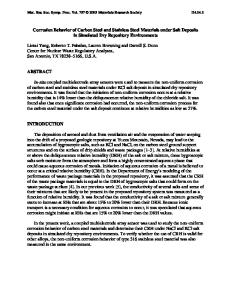Experiments and Modelling Studies Concerning Localised Corrosion of Carbon Steel and Stainless Steel Containers for Inte
- PDF / 728,389 Bytes
- 12 Pages / 414.72 x 648 pts Page_size
- 79 Downloads / 328 Views
EXPERIMENTS AND MODELLING STUDIES CONCERNING LOCALISED CORROSION OF CARBON STEEL AND STAINLESS STEEL CONTAINERS FOR INTERMEDIATE- AND LOW-LEVEL RADIOACTIVE WASTE A.R. HOCH, C.C.NAISH, S.M.SHARLAND, A.C.SMITH AND K.J.TAYLOR
AEA Technology, Harwell Laboratory, Oxfordshire OX1 1 ORA, UK ABSTRACT
Current plans for disposal of low- and intermediate-level radioactive wastes (LLW and ILW) in the UK include enclosing much of the waste in carbon steel or stainless steel containers. Modelling and experimental studies that aim to characterise the period and extent of the localised corrosion in these containers are described. The period, during which localised corrosion can be initiated and sustained in the post-closure phase of the repository is estimated. The likely modes of localised corrosion are identified, based on further consideration of the environmental conditions to which the metals are exposed. Detailed research in progress includes investigation of the rate of pitting corrosion for carbon steel, and the possible occurrence of crevice corrosion of stainless steel. I
INTRODUCTION
The design of radioactive waste repositories in many countries consists of a series of engineered barriers, including metal containers and backfill materials, such as cement or bentonite. These barriers aim to provide containment of the radionuclides (to varying degrees), by physically impairing their migration in dissolved form in the porewater of the repository, or by providing chemical conditions in which the concentrations of elements in solution are low, and sorption processes are favourable. The function of the containers falls generally into the former category, although metals will influence the chemical conditions within the repository porewater. Physical containment provided by the container may be considered as part of a longterm performance assessment of a particular disposal concept for radioactive waste. The desirable duration for physical containment to contribute effectively to the safety case will vary according to the type of waste (i.e. inventory of radioelements) and the location and design of the repository (for example, the composition of the other engineered barriers). On shorter timescales, physical containment is also an important consideration during the waste storage phase and the operational phase of the repository, from the point of view of handling the containers. However, such 'short' timescales may be of the order of tens of years. Corrosion is considered to be one of the main processes affecting the physical integrity of the containers. It will occur through contact with the natural waters permeating the repository on the outer surface of the container, and for hydrated wasteforms, through internal contact. Corrosion can take a number of forms, depending on the physical and Mat. Res. Soc. Symp. Proc. Vol. 294. ©1993 Materials Research Society
638
chemical environment of the metal. Localised corrosion is potentially one of the most rapid forms. It is characterised by small areas of a normally slowly-co
Data Loading...











